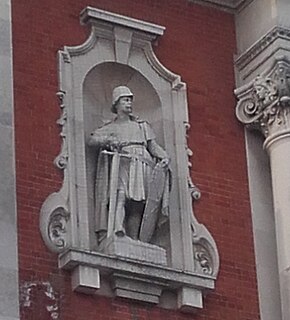Related Research Articles
William de Mandeville was an Anglo-Norman baron and Constable of the Tower of London.
Roger de Montgomery, also known as Roger the Great de Montgomery, was the first Earl of Shrewsbury, and Earl of Arundel, Sussex. His father was Roger de Montgomery, seigneur of Montgomery, and was a relative, probably a grandnephew, of the Duchess Gunnor, wife of Duke Richard I of Normandy. The elder Roger had large holdings in central Normandy, chiefly in the valley of the Dives, which the younger Roger inherited.
Richard de Luci was first noted as High Sheriff of Essex, after which he was made Chief Justiciar of England.
Aubrey de Coucy was the earl of Northumbria from 1080 until about 1086.
Richard de Courcy was a Norman nobleman and landholder in England.
Peter was a medieval cleric. He became Bishop of Lichfield in 1072, then his title changed to Bishop of Chester when the see was moved in 1075.

Eudo Dapifer ;, was a Norman aristocrat who served as a steward under William the Conqueror, William II Rufus, and Henry I.

William de Chesney was an Anglo-Norman magnate during the reign of King Stephen of England and King Henry II of England. Chesney was part of a large family; one of his brothers became Bishop of Lincoln and another Abbot of Evesham Abbey. Stephen may have named him Sheriff of Oxfordshire. Besides his administrative offices, Chesney controlled a number of royal castles, and served Stephen during some of the king's English military campaigns. Chesney's heir was his niece, Matilda, who married Henry fitzGerold.
Henry fitzGerold was a 12th-century Anglo-Norman nobleman and government official.
Roger de Valognes was an Anglo-Norman nobleman who held lands around Benington in Hertfordshire.

Walter de Lacy was a Norman nobleman who went to England after the Norman Conquest of England in 1066. He received lands in Herefordshire and Shropshire, and served King William I of England by leading military forces during 1075. He died in 1085 and one son inherited his lands. Another son became an abbot.
William, Count of Évreux was a powerful member of the Norman aristocracy during the period following the Norman conquest of England. He is one of the few documented to have been with William the Conqueror at the Battle of Hastings.
William Paynel was an Anglo-Norman nobleman and baron.
William fitzWimund was a Norman landholder in England after the Norman Conquest.
Hasculf de Tany was a nobleman in medieval England and castellan of the Tower of London.
Geoffrey Talbot was an Anglo-Norman nobleman in medieval England.
Rohese Giffard was a Norman noblewoman in the late 11th and early 12th century.

de Mandeville is the surname of an old Norman noble family originating from Normandy. The first records are about Geoffrey de Mandeville, Norman conqueror. The de Mandeville family, held lands in England and France.
Geoffrey de Mandeville was the Sheriff of Devon, England between 1100 and 1116 and also baron of Marshwood in Dorset. Marshwood is near the border of Devon and Dorset, 5.5 miles north-east of Lyme Regis.
Hugh fitzBaldric was a Norman nobleman and royal official in England after the Norman Conquest of England.
References
- 1 2 3 4 K.S.B. Keats-Rohan, Domesday People, I Domesday Book, (Boydell Press, 1999) pp. 226–7
- ↑ Ronald Sutherland Gower, The Tower of London, Vol. ii (George Bell & Sons, 1902), p. 179
- ↑ http://www.villages76.com/pagesmannevillette/ecolehistorique.html#histoire Archived 2015-02-15 at the Wayback Machine Mannevillette History (in French)
- ↑ Lewis Christopher Loyd, The origins of some Anglo-Norman Families, (Genealogical Publishing Co., Baltimore, 1999) pp. 57–8
- ↑ Alexander Malet, The Conquest of England, (Bell and Daldy, London, 1860) p. 191 n. 18
- ↑ J. H. Round, Geoffrey de Mandeville, (Longmans, Green, 1892), p. 37
- ↑ David C. Douglas,William the Conqueror (University of California Press, 1964). p. 297
- ↑ George Edward Cokayne, The Complete Peerage, Vol. V (The St. Catherine Press, Ltd., London, 1926), pp. 113–16
- 1 2 K.S.B. Keats-Rohan, Domesday People, I Domesday Book, (Boydell Press, 1999) p. 227
- ↑ J. H. Round, Geoffrey de Mandeville, (Longmans, Green, 1892), p. 38
- ↑ K.S.B. Keats-Rohan, Domesday People, I Domesday Book, (Boydell Press, 1999), p. 194
- ↑ K.S.B. Keats-Rohan, Domesday People, I Domesday Book, (Boydell Press, 1999), p. 229
- ↑ Ann Williams, G.H. Martin, Domesday Book; A Complete Translation, (Penguin Books, 1992) p. 85